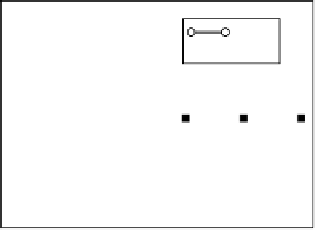Information Technology Reference
In-Depth Information
Inhibition of Return Effect
effect for the valid trials relative to the invalid ones, the
ordering of valid and invalid trials actually reverses at
the long delays (e.g., Maylor, 1985). This phenomenon
has been labeled
inhibition of return
, to denote the idea
that there is something that inhibits the system from re-
turning attention to the cued location after a sufficient
delay.
Our model can be used to simulate at least the qual-
itative patterns of behavior on the Posner task over dif-
ferent delays. This is done by varying the length of cue
presentation (a variable delay event could have been in-
serted, but residual activation would persist anyway, and
varying the cue length is simpler), and turning on the ac-
commodation current, which causes neurons that have
been active for a while to “fatigue” (see section 2.9 in
chapter 2 for details). Thus, if the cue activation persists
for long enough, those spatial representations will be-
come fatigued, and if attention is subsequently directed
there, the network will actually be slower to respond.
Also, because the spatial activations have fatigued, they
no longer compete with the activation of the other loca-
tion for the invalidly cued trials, eliminating the slow-
ing.
Now, let's see this in the model.
100
Valid
Invalid
75
50
25
75
100
125
150
175
200
Cue − Target Interval (Cycles)
Figure 8.28:
Inhibition of return effect seen with long inter-
stimulus intervals between the cue and target (175-200 cy-
cles) as a result of accommodation of the spatial representa-
tions. Here the network is slower to respond to the validly
cued location compared to the invalidly cued one.
Question 8.12
Report in detail what happens on the
valid and invalid trials that produces the inhibition of
return effect.
First, press the
Defaults
button to restore
the default parameters, and then un-lesion the net-
work by doing
Lesion
and selecting
NO_LESION
for
the
lesion_lay
parameter. Next, set
env_type
to
STD_POSNER
. Then, set
accom
to
ACCOMMODATE
in the
control panel (
Apply
). Next, let's choose a cue duration
that, even with the accommodation channels active, still
produces the original pattern of results. Set
cue_dur
to
75. Now, do a
Batch
run.
You should observe the now-familiar pattern of a
valid facilitation and an invalid slowing.
,
!
Object-Based Attentional Effects
So far, we have explored spatially mediated attentional
effects. However, the very same mechanisms (and
model) can be used to understand object-based atten-
tional effects. For example, instead of cuing one re-
gion of space, we can cue one object, and then present a
display containing the cue object and another different
object, and determine which of the two objects is pro-
cessed more readily. By analogy with the Posner spatial
cuing paradigm, we would expect that the cued object
would be processed more readily than the non-cued one.
Of course, one would have to use different, but similar
cue and target objects to rule out a target detection re-
sponse based on the cue itself.
Because a simple object recognition task is problem-
atic, the object-based attention studies that have been
run experimentally typically involve a comparison be-
tween two operations (e.g., detecting a small visual tar-
get) on one object versus two operations on two dif-
Batch
run with increasing durations (change using
the
cue_dur
field) in increments of 25 from 75 to 200.
You should see that the valid-invalid difference de-
creases with increasing duration, equalizes at 125
epochs, and by 150 epochs, the validly cued condition
is actually
slower
than the invalidly cued one, which
is the hallmark of the inhibition of return phenomenon
(figure 8.28).
Step
through the running of the network with
cue_dur
at 150.










Search WWH ::

Custom Search